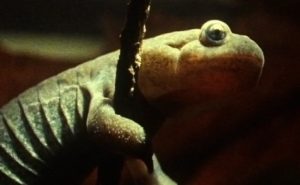
Siberian Salamander Facts, That you Don’t Know
The Siberian salamander is a species of salamander in the Hynobiidae family, found in Northeast Asia. It was discovered in the tundra near the Arctic Ocean. Its prevalence covers the north of Korea, China, Japan, and Mongolia. The species is known to survive extreme temperatures (-45 ° C).
Do check: Facts related to Piranha fish
Salamanders are inveterate couch potatoes: in their entire lives, they do not move more than a mile from their home. With temperature changes, this can be disastrous, and every winter, salamanders die in huge numbers. There is, however, one species that managed to solve the climate problem.
The Siberian salamander has adapted to live in such harsh conditions that other tailed amphibians cannot exist. Before hibernating, the salamander secretes an anti-frost chemical that allows the last ice age to end – 10,000 years ago.
Siberian Salamander Facts Summary
Habitat: Wet woods and riparian groves.
Location: North-East Asia.
Lifespan: 12-15 Years.
Size: 9.0 to 12.5 cm.
Weight: Around 150 gm.
Color: Bluish-brown
Diet: Larvae, Worms, Insects, Mollusks, Squids, Bugs, and Eggs of other salamanders.
Predators: Other larger salamanders, Birds of prey.
Conservation Status: Least Concern
Mating Season: Spring
Species: Salamandrella keyserlingii

also read: facts related to water moccasin
This animal is also called the four-toed eternity, but a more familiar name -Siberian salamander. Eternity has a brown color on the upper part of the body, but it is not monochromatic, you can see a variety of stains, spots, stripes, but not bright colors. The tail is usually shorter than the torso, but can sometimes be longer.
The maximum body length of the Siberian salamander reaches 72 mm, and taking into account the tail reaches 162 mm.
The shape of the body, like other Newts, is a long, slightly elliptical, flat head, with limbs on the sides and fingers. Although this cub is called four fingers, not all individuals have four fingers. Salamanders can be found with three and five fingers.
Salamanders are one of the few animals that have adapted to survive in permafrost, so they are not afraid to even freeze.
Habitats of Siberian Salamander
Salamanders are most convenient to live in low-lying areas with water bodies such as rivers, swamps, or lakes. They can be found in mixed, coniferous, or deciduous forests. They are not too afraid of people, they often meet in parks, by railroads, and villagers often see them.
Moreover, found in various forests: birch, coniferous, mixed, alder, and broad-leaved.
Siberian salamanders are ecologically plastic, that is, they can survive in different conditions. They mostly prefer bushy or wooded areas, but they are also found in open areas.
Siberian Salamander Character and lifestyle
The main activity of this adult amphibious plane falls during the day or at night. During the day, hide in all kinds of shelters and wait for the darkness to begin. However, salamander larvae do not cease their activity during the day.
These animals can survive cold weather as well, but cannot withstand the cold when awake.
Salamanders appear on the surface, at different latitudes when the snow begins to melt. The ability of this type of newt is to tolerate low temperatures; they do not lose activity at 0 degrees. Therefore, they can even survive at the North Pole.
The larvae feed on crustaceans, molluscs, and aquatic insects. Adults that live on land eat earthworms, insects, molluscs, and other invertebrates.
The most common winter cubs are buried in a thick layer of fallen leaves, dust from old stumps, dead trees, or simply in the ground. In the dormant state of the salamander there, it takes 5 to 8 months.
The clutch of the Siberian salamander is located on snags, aquatic plants. Development of eggs – up to 4 weeks, after the same number of larvae, develop.
Feeding
The basic diet consists of salamander larvae, and all types that can be caught. There is enough food in the humid places where Newt often lives, so there is nowhere to rush and it does not move quickly.
Reproduction and Lifespan
As soon as the salamander comes out of hibernation, it immediately starts reproduction after several days. To draw attention to the female, the male takes care of the female, clasping a twig in the water; he makes movements sideways, while bending his tail in a wave-like manner.
After that, the female attaches a kind of sac with caviar to the branch, and the male attaches a capsule with sperm over this caviar sac. The masonry is in the form of spiral bags fill with caviar and joined together. They are fixed on the branches of plants and are located shallow in the water. Over time, the bags begin to swell and become larger. In such a bag, there may be 14 dark eggs, and 170 is the fertility of each woman individually. The development of future offspring directly depends on the water temperature.
The warmer the water, the faster the larvae form.
Behavior
Siberian salamanders live in wet grasslands, wetlands, and wooded areas covered with moss, fallen leaves, or dead trees in wet meadows, located near spawning reservoirs. It can be river floodplains, ponds, lakes, puddles, and slow-flowing streams.
This species is active in the temperature range from 0.5 ° C to 27 ° C. If the temperature is high, amphibians die.
Conservation status
Siberian salamanders are quite common, and in some places, their numbers are very wide. But in certain areas, for example, in the Amur region, they are rare. After the second winter, newts reach puberty.
More Facts about Siberian salamanders
- Heat and sun harm salamanders, in such conditions they quickly lose their strength and soon die.
- In the wild, the maximum lifespan of Siberian salamanders is 13 years.
- After the larvae emerge, they feed on various aquatic insects, crustaceans, and molluscs.
- The diet of adults includes molluscs, earthworms, insects, and other invertebrates.
- After the snow melts, the salamanders come to the surface. If the temperature there is even 0 degrees, the newts will not lose activity.
- Such newts were found frozen in ice, and after thawing, the animals revived.
- The Siberian salamander differs from other representatives of this genus, on its hind limbs there are only 4 fingers.
- During mating, the male representative embraces the female with its tail from below, like a hook, and then with its limbs. When the caviar sacs appear, it releases semen, fertilizing them.
How long does a siberian salamander lives? A normal siberian salamander can survive 8 years in the wild but in domestic area the lifespan could be lower than the normal. these are capable to hibernate like frogs, siberian salamander hibernates in ice and sometimes get dead if the water oxygen level goes no to extrememly low.
Conclusion (Siberian salamander facts):
We have gone through some biological facts related to the Siberian salamander. This is a quite beautiful animal, in fact all animals are very cute and innocent, we should love and show care to them in order to protect them as these are an addon to this nature and also are natural resources to mankind.
You may also enjoy reading: